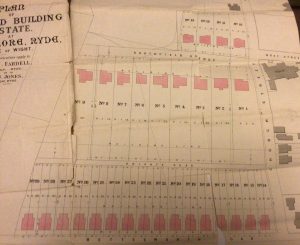Ryde Architecture
SOUTHFIELD, Swanmore (picture right – from the sale brochure 1889)
We know that the meadow of Southfield nearest to Swanmore Church was well-known and celebrated for its mushrooms, as in September 1873 P.C. Smith was watching Mr. Brown’s field and spotted two men trespassing and picking mushrooms. They were soon in court for stealing 2s. worth of mushrooms. The fine and costs incurred, proved greater than the value of the goods.
The extensive grounds of Southfield were ideal for many events. During the Bank Holiday of August 1878, the principal local event was the demonstration of Court Astraea of Foresters and Shepherds, which was held in the grounds of Southfield with kind permission of H. D. Brown, Esq. J.P. The members of the two orders marched through the streets of the town in procession, in their regalia, headed by the Volunteer Band. At Southfield all sorts of sports were indulged in, till the heavy rain in the evening broke up the happy party.

Southfield Building Plots 1879.
On Thursday 21st August 1879, over 6 acres of the Southfield Estate, freehold building land, to be let in lots, was offered for sale by auction by E. Marvin & Sons. Plans had already been drawn up (left), which showed 9 large villas, fronted by a new road to be laid down, the road to be called Southfield Avenue, with 4 smaller villas also fronting the new road. The rear gardens of these villas stretched down to a private road which separated them from the back gardens of properties proposed for the north side of Bettesworth Road.
The row of villas and Southfield Avenue were to reach as far as the boundary of Church Street, opposite St. Michael’s Church
The dwellings for Bettesworth Road shown on the map (left) were to be much smaller semi-detached houses.
None of these building plots were sold at that time, because the whole Southfield Estate was advertised for sale in May 1889 with auction on 6th August 1889, and the map with the property brochure showed no other buildings. The boundaries being Upton Road, Church Street and Bettesworth Road. The whole property comprising about 11 acres. It stated that the enclosure of capital grass land of about 7 acres, having good frontage to two roads and was capable of utilisation for building purposes without detriment to the residential character of the Estate.
Other details listed: A family house, substantially built of white brick, approached by a broad carriage drive protected by a pretty Entrance Lodge containing four rooms.
First Floor: Nine Bedrooms with Dressing Room, over two wings, approached by a second staircase, Bath Room with hot and cold supplies and a Housemaid’s Room with w.c. with water supply.
Ground Floor: Porch, Entrance Hall and Corridor opening onto a Terrace Walk, Dining Room, Drawing Room, Verandah and Lawn, Library, Study and w.c. Domestic Offices and Pleasure Grounds. Kitchen Garden and Orchard, Vinery, Conservatory, a 3-Stall Stable and Loft, and a Bakehouse and Oven.
Other Southfield residents over the years were: In 1860 Mr William H. Hamilton, Retired Paymaster RN. and Mrs Catherine Hamilton. In May 1862 Dr Learmouth of Yarborough-villa purchased Southfield House, the late residence of W. H. Hamilton, Esq. Dr. and Mrs Learmouth and family were at the house till at least April 1866. Then by October 1866 H. D. Brown, Esq. J.P. and Mrs Brown were in residence, they remained for about 21 years. Mr and Mrs E. Crossley appeared to have been at the property from July 1895 till January 1905. In 1906 Alderman Arthur Andrews and his family were living at Southfield until his death in 1942, and Captain Arthur Newton Andrews until 1962.
Sources: IW Observer, For Sale Catalogues
Article: Ann Barrett

